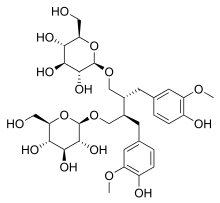Secoisolariciresinol diglucoside
 | |
| Names | |
|---|---|
| Other names
SDG | |
| Identifiers | |
3D model (JSmol) |
|
| ChemSpider | |
PubChem CID |
|
| UNII | |
| |
| |
| Properties | |
| C32H46O16 | |
| Molar mass | 686.7 g/mol |
Except where otherwise noted, data are given for materials in their standard state (at 25 °C [77 °F], 100 kPa). | |
| Infobox references | |
Secoisolariciresinol diglucoside (SDG) is an antioxidant[1] phytoestrogen present in flax, sunflower, sesame, and pumpkin seeds. In food, it can be found in commercial breads containing flaxseed.[2] It is a precursor of mammal lignans[3] which are produced in the colon from chemicals in foods.
Extraction
Secoisolariciresinol diglucoside can be isolated from de-fatted (hexane extraction) flaxseed by extraction of the lignan polymer precursor with a water/acetone mixture, followed by acetone removal and alkaline hydrolysis.[4]
Or, it can be extracted from the shell of whole flax through a cold-milled process without using chemicals.
Studies on biological effects
Secoisolariciresinol diglucoside slows the growth of human breast cancer in mice.[5]
Secoisolariciresinol diglucoside may play very different role in people with the already existent cancer. In the Grade IV histology group of adult patients diagnosed with malignant glioma, high intake of secoisolariciresinol (for highest tertile compared to lowest tertile, in all cases) was associated with poorer survival.[6] Note however that glioma is located behind the Blood–brain barrier in which larger molecules such as SDG may not penetrate efficiently.
In rabits SDG reduced hypercholesterolemic atherosclerosis and this effect was associated with a decrease in serum cholesterol, LDL-C, and lipid peroxidation product and an increase in HDL-C and antioxidant reserve.[7]
References
- ↑ Adolphe, J. L., Whiting, S. J., Juurlink, B. H. J., Thorpe, L. U., & Alcorn, J. (2010). Health effects with consumption of the flax lignan secoisolariciresinol diglucoside. The British Journal of Nutrition, 103(7), 929–38. http://doi.org/10.1017/S0007114509992753
- ↑ Phenolic glucosides in bread containing flaxseed. C. Strandås, A. Kamal-Eldin, R. Andersson and P. Åman, Food Chemistry, Volume 110, Issue 4, 15 October 2008, Pages 997–999, doi:10.1016/j.foodchem.2008.02.088
- ↑ Thompson, LU; Robb, P; Serraino, M; Cheung, F (1991). "Mammalian lignan production from various foods". Nutrition and Cancer. 16 (1): 43–52. doi:10.1080/01635589109514139. PMID 1656395.
- ↑ U.S. Patent 6,806,356 Process for recovering secoisolariciresinol diglycoside from de-fatted flaxseed.
- ↑ Chen; et al. (2009). "Flaxseed and Pure Secoisolariciresinol Diglucoside, but Not Flaxseed Hull, Reduce Human Breast Tumor Growth (MCF-7) in Athymic Mice". The Journal of Nutrition. 139 (11): 2061–6. doi:10.3945/jn.109.112508. PMID 19776177.
- ↑ Delorenze, Gerald N; McCoy, Lucie; Tsai, Ai-Lin; Quesenberry Jr, Charles P; Rice, Terri; Il'Yasova, Dora; Wrensch, Margaret (2010). "Daily intake of antioxidants in relation to survival among adult patients diagnosed with malignant glioma". BMC Cancer. 10: 215. doi:10.1186/1471-2407-10-215. PMC 2880992. PMID 20482871.
- ↑ Prasad, K (1999). "Reduction of Serum Cholesterol and Hypercholesterolemic Atherosclerosis in Rabbits by Secoisolariciresinol Diglucoside Isolated from Flaxseed". Circulation. 99 (10): 1355–1362. doi:10.1161/01.CIR.99.10.1355.
External links
- Flaxseed Lignans & the Immune System Lists many academic sources.